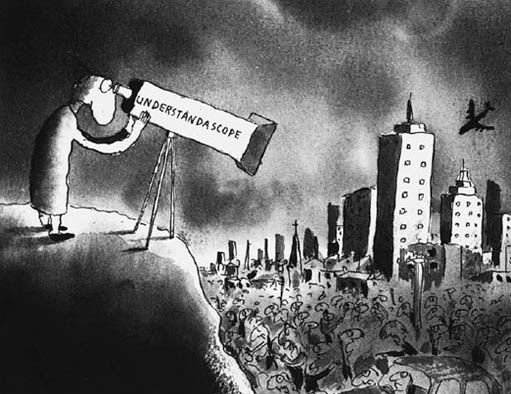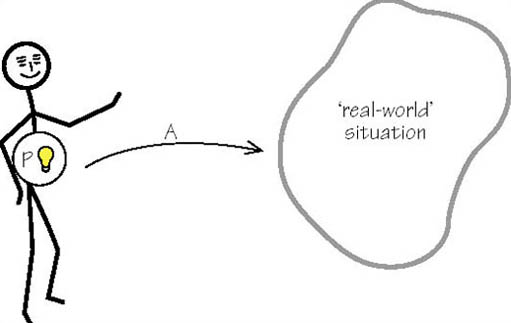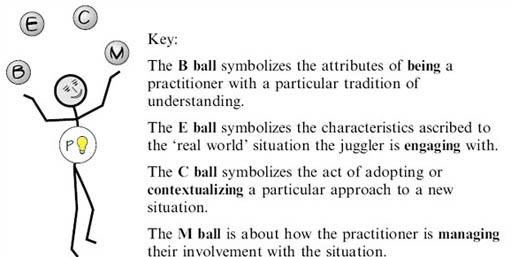11 Part 3 Understanding systems approaches to managing complexity
11.1 Part 3: 1 Introduction
I wonder if you experience complexity in your daily life? Perhaps you experienced the child-support case study as being complex, as I did? For much of the time I struggle to keep my head above water as I try to understand and manage the complexity I experience as part of everyday life. I find social commentator and cartoonist Michael Leunig's depiction of a solitary figure looking through an ‘understandascope’ (Figure 19) a particularly skilled way of capturing the sense of bewilderment I sometimes feel. For the purposes of Part 3 I am using his cartoon featuring the ‘understandascope’ because it raises a number of important questions relevant to my aims. Using Figure 19 as a metaphor, these questions are:
What is it about individual human beings that characterises how they observe the world? i.e. what are the properties of the observer looking through the understandascope?
How do humans engage with the world around them? i.e. what are the properties of the understandascope?
What sense do humans make of the world they experience? i.e. what sense is the observer able to make about the ‘messy’ sea of human activity that is being engaged with through the understandascope?
Does the observer stand outside the ‘messy’ situation being observed or do the properties of the ‘understandascope’ – the way in which s/he engages with the world – enable the observer to be an effective actor in it?
What new understandings does the observer have after engaging with the situation through the understandascope?

It will take about 40 hours to study this part of the unit.
I use Leunig's cartoon as a means to introduce my ideal of a systems practitioner. As you work through this part of the unit I want to invite you to imagine an ideal systems practitioner as a type of understandascope, as a lens through which to develop your own systems practice and to respond to the questions posed above. By ideal, I do not mean highly desirable. I am using the term in a philosophical sense meaning a set of ideas about, or a model of, a systems practitioner.
At the end of this free course, my aim is that you will have a greater understanding of ‘systems approaches to managing complexity’. But what makes it possible to say ‘I understand someone or understand something about the world in which I live?’ Is there a state of mind or body that can usefully be referred to as understanding? By the end of this free course our hope is to have provided the means to respond to the question: What is it that we would need to have observed, in others or in ourselves, for us to say that understanding systems practice had occurred? In the language of the cartoon I am asking you to envisage
yourself as the observer;
the ideal systems practitioner as the understandascope; and
the complexity you are trying to understand as residing in the relationship between the observer (you), the understandascope (your appreciation of systems practice), and the context (the messy situation depicted in the cartoon).
You might find it helpful to return to this section as the unit goes on. This will enable you to see how the issues raised here are taken up in subsequent parts from different perspectives.
Figure 20 illustrates the general idea of a practitioner, P. I am using the idea of the practitioner as someone who engages with some so-called ‘real world’ situation in practice, using selected approaches.

I am using the phrase ‘real world’ to distinguish from the conceptual world, the world of thinking. In many ways this is an artificial distinction because the world I perceive to be the ‘real world’ is, in fact, my own conceptual model. What I perceive is conditioned by my conceptual models. So for me the real ‘real world’, is unknowable. My desire is to change the question from ‘what is the world’ to ‘how do I know the world’. So every time I use the term ‘real world’ you should remember that this is a short-hand for the process of coming to know the world.
Later, I will introduce the idea of the systems practitioner who is a special case of the general practitioner. Figure 19 also depicts a form of practice – a person using an understandascope to do something.
In this unit, the idea of practice, or practising, is a general one in that it is something everyone does. The dictionary definition of practise is ‘to carry out or perform habitually or constantly … to carry out an action’. Almost everyone has some role in which they practise. Most people occupy a number of roles, in their work or in their community. In these roles it is usual to encounter a number of issues that need dealing with, improving, resolving, or obviating. For example I am a practising father as well as a practising academic.
Activity 31
In your Learning Journal list some of the practices you engage in personally and professionally. Suggest some measures of performance for these practices, i.e. how do you know if you do them well?
Answer
For the purposes of this exercise I will refer to my practises as a father and as a researcher. I will use the following table to complete my answer.
| Practice | Measure of performance | How do I know if I do it well? |
|---|---|---|
| Fathering | Nature of communication with my daughter | We talk regularly and usually enjoy our conversations – my daughter gives me feedback and I listen (mostly!) |
| Emotional quality of our relationship | I feel loved and understand this is reciprocated | |
| Extent of mutual respect | Manifest through mutual engagement in each others work/ideas | |
| Extent of trust | By my daughter never feeling the need to have my permission to do something and by the lack of actions that betray my trust | |
| Researching | Grants obtained | Am fully committed with a number of large grants in last three years |
| Papers published | Two per annum is target which I usually meet | |
| Invitations to talk/participate | These continue to arrive | |
| Extent of personal satisfaction | I enjoy myself when researching – but find admin distracts me | |
| Usefulness to others | More difficult – based on feedback and personal judgement |
It was much easier to think of measures of performance in my professional practice than in my personal practice. But on the other hand more is at stake, for me, in my personal practice.
It follows from the dictionary definition that a practitioner is anyone involved in practice – in carrying out an action. If I reflect on my own practice, I am aware that what I do is not as simple as the interaction between practitioner and situation portrayed in Figure 20. I experience myself as something of a juggler trying to keep a number of balls in the air as I practise.

In this unit we employ the metaphor of the systems practitioner as juggler and now I am going to focus on four particular balls we (the course team) think need to be kept in the air for any form of effective systems practice (Figure 21).
Based on my experience, I claim that effective practice involves being aware that these four balls need to be juggled – it takes active attention, and some skill, to keep them all in the air. Things start to go wrong if I let any one of them slip. To be an effective practitioner, I find I have to continuously think about, and act to maintain, four elements: the processes of being a practitioner, my appreciation of the situation I engage with, putting the approach taken into context and managing in the situation. The four verbs, the activities, I am drawing your attention to are being, engaging, contextualising, and managing. The remainder of the unit is structured around these four balls being juggled by a systems practitioner.
